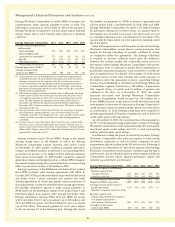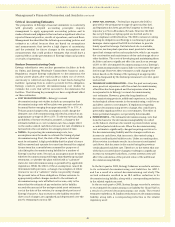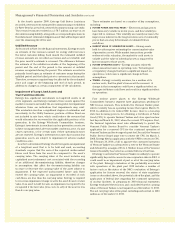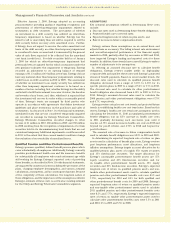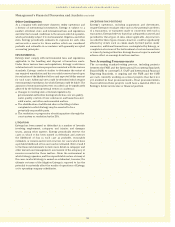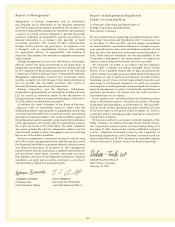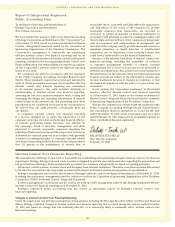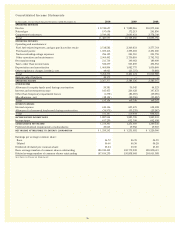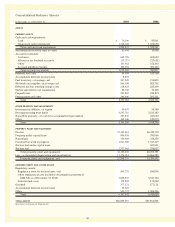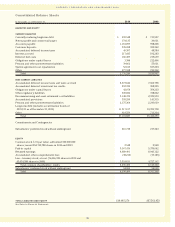Entergy 2010 Annual Report Download - page 54
Download and view the complete annual report
Please find page 54 of the 2010 Entergy annual report below. You can navigate through the pages in the report by either clicking on the pages listed below, or by using the keyword search tool below to find specific information within the annual report.
Management’s Financial Discussion and Analysis continued
Cost Sensitivity
The following chart reflects the sensitivity of qualified
pension cost to changes in certain actuarial assumptions
(dollars in thousands):
Impact on
Qualified
Impact on 2010 Projected
Change in Qualified Benefit
Actuarial Assumption Assumption Pension Cost Obligation
Increase/(Decrease)
Discount rate (0.25%) $13,682 $131,414
Rate of return on plan assets (0.25%) $ 7,634 –
Rate of increase in
compensation 0.25% $ 6,367 $ 30,374
The following chart reflects the sensitivity of postretirement
benefit cost to changes in certain actuarial assumptions (dollars
in thousands):
Impact on
Accumulated
Impact on 2010 Postretirement
Change in Postretirement Benefit
Actuarial Assumption Assumption Benefit Cost Obligation
Increase/(Decrease)
Health care cost trend 0.25% $6,500 $34,291
Discount rate (0.25%) $4,375 $40,557
Each fluctuation above assumes that the other components of
the calculation are held constant.
ACCOUNTING MECHANISMS
Effective December 31, 2006, accounting standards required an
employer to recognize in its balance sheet the funded status of
its benefit plans. Refer to Note 11 to the financial statements for a
further discussion of Entergy’s funded status.
In accordance with pension accounting standards, Entergy
utilizes a number of accounting mechanisms that reduce the
volatility of reported pension costs. Differences between actuarial
assumptions and actual plan results are deferred and are
amortized into expense only when the accumulated differences
exceed 10% of the greater of the projected benefit obligation
or the market-related value of plan assets. If necessary, the
excess is amortized over the average remaining service period of
active employees.
Entergy calculates the expected return on pension and other
postretirement benefit plan assets by multiplying the long-term
expected rate of return on assets by the market-related value
(MRV) of plan assets. Entergy determines the MRV of pension
plan assets by calculating a value that uses a 20-quarter phase-in
of the difference between actual and expected returns. For other
postretirement benefit plan assets Entergy uses fair value when
determining MRV.
COSTS AND FUNDING
In 2010, Entergy’s total qualified pension cost was $147.1 million.
Entergy anticipates 2011 qualified pension cost to be $154
million. Pension funding was $454 million for 2010. Entergy’s
contributions to the pension trust are currently estimated to
be approximately $368.8 million in 2011, although the required
pension contributions will not be known with more certainty until
the January 1, 2011 valuations are completed by April 1, 2011.
Minimum required funding calculations as determined under
Pension Protection Act guidance are performed annually as of
January 1 of each year and are based on measurements of the
assets and funding liabilities as measured at that date. Any
excess of the funding liability over the calculated fair market value
of assets results in a funding shortfall which, under the Pension
Protection Act, must be funded over a seven-year rolling period.
The Pension Protection Act also imposes certain plan limitations
if the funded percentage, which is based on a calculated fair
market values of assets divided by funding liabilities, does not
meet certain thresholds. For funding purposes, asset gains and
losses are smoothed in to the calculated fair market value of
assets and the funding liability is based upon a weighted average
24-month corporate bond rate published by the U.S. Treasury;
therefore, periodic changes in asset returns and interest rates
can affect funding shortfalls and future cash contributions.
Total postretirement health care and life insurance benefit costs
for Entergy in 2010 were $111.1 million, including $26.6 million
in savings due to the estimated effect of future Medicare Part D
subsidies. Entergy expects 2011 postretirement health care and
life insurance benefit costs to be $114.7 million. This includes a
projected $33 million in savings due to the estimated effect of
future Medicare Part D subsidies. Entergy contributed $75 million
to its postretirement plans in 2010. Entergy’s current estimate of
contributions to its other postretirement plans is approximately
$78 million in 2011.
FEDERAL HEALTHCARE LEGISLATION
The Patient Protection and Affordable Care Act (PPACA) became
federal law on March 23, 2010, and, on March 30, 2010, the Health
Care and Education Reconciliation Act of 2010 became federal law
and amended certain provisions of the PPACA. These new federal
laws change the law governing employer-sponsored group health
plans, like Entergy’s plans, and include, among other things, the
following significant provisions:
n A 40% excise tax on per capita medical benefit costs that
exceed certain thresholds;
n Change in coverage limits for dependants; and
n Elimination of lifetime caps.
The total impact of PPACA is not yet determinable because
technical guidance regarding application must still be issued.
Additionally, ongoing litigation and political discussions are
in progress regarding the constitutionality of and the potential
repeal of health care reform, although whether that occurs
and what parts of health care reform would be invalidated or
repealed is not yet known. Entergy will continue to monitor these
developments to determine the possible impact on Entergy as a
result of PPACA. Entergy is participating in the programs currently
provided for under PPACA, such as the early retiree reinsurance
program, which may provide for some limited reimbursements
of certain claims for early retirees aged 55 to 64 who are not yet
eligible for Medicare.
One provision of the new law that is effective in 2013 eliminates
the federal income tax deduction for prescription drug expenses
of Medicare beneficiaries for which the plan sponsor also receives
the retiree drug subsidy under Part D. Entergy receives subsidy
payments under the Medicare Part D plan and therefore in the
first quarter 2010 recorded a reduction to the deferred tax asset
related to the unfunded other postretirement benefit obligation.
The offset was recorded as a $16 million charge to income tax
expense or, for the Utility, including each Registrant Subsidiary,
as a regulatory asset.
52








